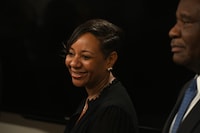
“It’s become abundantly clear to me that our board of education is having a difficult time working together, and it’s clear that we have a division in our philosophical beliefs about how to move Prince George’s County Public Schools forward,” Goldson said in an interview Thursday. “While the acrimony has taken place well before the current chair and I remained hopeful that we could at least come to some agreement and resolution, it was just clear to me that we’re not able to move forward.”
Today, after 32 years with @pgcps, I announced my next journey: retirement. It has been an absolute honor to lead 131K+ students in the place I call home. There is no place better than Prince George’s County Public Schools and I will always be #PGCPSProud. https://t.co/V4bYNN8jil
— CEO Monica Goldson (@drmonicaceo) January 5, 2023
Years of infighting on the Prince George’s school board have been marked by raucous board meetings, member resignations, damning state audits and legal challenges. Observers say the school board is dysfunctional and is a detriment to the system’s roughly 131,000 students.
The school board issued a statement, signed by former chair Juanita Miller and vice-chair Lolita E. Walker, on Thursday congratulating Goldson on her retirement. The statement did not address Goldson’s criticism of the board.
Miller is awaiting a ruling from a disciplinary hearing on state-issued charges of misconduct in office, neglect of duty and incompetence. Disagreements on the board have persisted during Miller’s leadership, but members could not reach a consensus in a vote for a new chair last month.
Goldson took over as interim CEO in July 2018, and was selected as the permanent leader a year later. She previously served as deputy superintendent for teaching and learning during her 32-year career with the school system. Her contract is set to expire June 30.
“Since 1991, I have truly enjoyed serving the students and families of Prince George’s County Public Schools. From a mathematics teacher and cheerleading coach to Chief Executive Officer, my career has taken me to heights I never dreamed possible when I walked across the stage in 1986 as a Potomac High School graduate,” Goldson wrote in her announcement, titled “My Next Journey.”
Goldson was a popular leader in the county but faced criticism from some parents and officials for keeping Prince George’s students learning virtually longer than all other school systems in the state. Gov. Larry Hogan (R) disagreed with her decision to return the district to virtual learning in January 2021 after a jump in coronavirus cases, calling it a “terrible mistake” because of the difficulties students faced with remote learning the previous year.
District assessments show most of the county’s students are scoring below grade level and not meeting expectations in math and reading. More data on the county’s students is expected later this month.
County Executive Angela D. Alsobrooks — who appointed Goldson to the position permanently in 2019 — thanked Goldson for her service to the school system. Goldson displayed “steadfast leadership and strong partnership” that helped the school system navigate virtual learning during the pandemic and break ground on 10 new schools, Alsobrooks said in a statement.
Alsobrooks said her goal is to have a new chief executive in place by June 30, when Goldson’s contract ends.
Goldson said she made her retirement decision with family over winter break, and announced it early to allow time for a national search for a successor. Additionally, she is required to announce by Feb. 1 of the year her contract expires if she intends to stay, she said.
Goldson lauded employees’ work to support students during the pandemic and listed several successes during her tenure, including the mental health supports offered to students and staff, and instructional programs built to help students catch up academically after roughly two years of virtual instruction. A challenge the school system continues to face is getting school board members to unify, she said.
In interviews, board members said they predicted Goldson would leave as her contract expiration date approached, but some disagreed with her targeting them in her decision.
“I think it was really unnecessary finger-pointing on the way out the door,” said David Murray (District 1). “I don’t think she needed to try to blame anyone else for her leaving.”
Judy Mickens-Murray, an appointed At-Large member, expected Goldson to be recruited elsewhere but did not predict retirement. She said the board was shortsighted for not giving Goldson sufficient credit for the knowledge she brought to the school system as a graduate and decades-long employee. The climate around the board was untenable for Goldson and her initiatives were “triaged by board members who believe they have a better understanding of what processes we need to put in place,” Mickens-Murray added.
“I think we wore Dr. Monica Goldson down, I really do,” she said.
Vladimir Kogan — an associate professor at Ohio State University who researches education governance and how elections affect student learning outcomes — said that there’s not convincing data on the impact a superintendent’s departure has on a school district, but studies on principal and teacher turnover show that it leads to declines on student achievement.
“If anything, it’s probably the case that the impacts are just as pernicious,” he said, noting that other actions come to a halt as other top administrators begin a job search since they’re uncertain if the next superintendent will keep them.
After Goldson retires, she plans to spend time at home with family members. She did not have plans to apply elsewhere.
Lateshia Beachum contributed reporting.